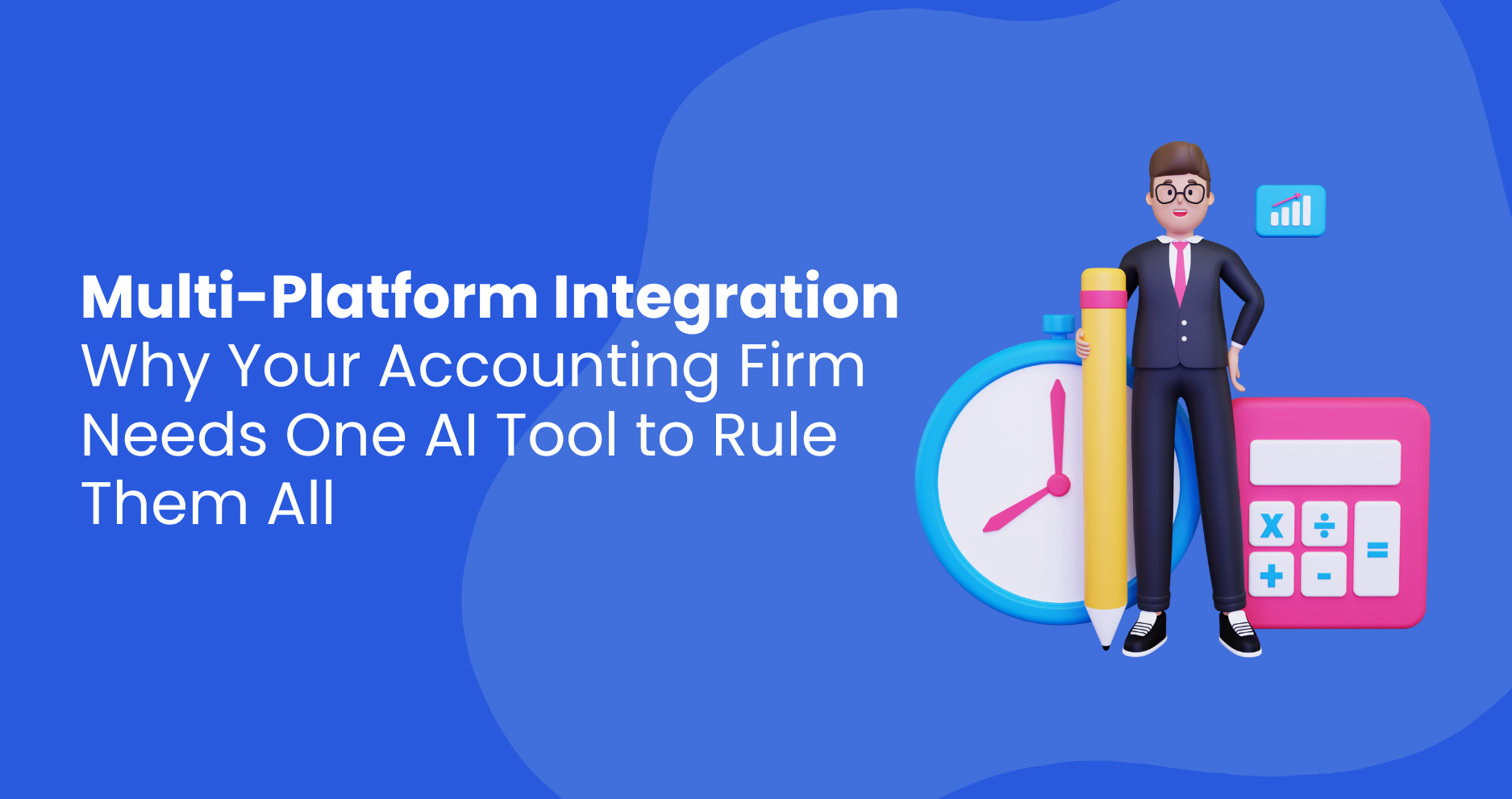The average accounting firm manages clients across 4-6 different accounting platforms. This fragmentation is inconvenient and costs your firm thousands of dollars in lost productivity, increased error rates, and client frustration. AccountsGPT is revolutionizing how accounting firms handle multi-platform client management.

The modern accounting firm operates in a fragmented digital landscape. Your small business client swears by QuickBooks Online, while your manufacturing client insists on NetSuite. The local restaurant chain uses Xero, and your nonprofit client still manages everything through Excel spreadsheets. Meanwhile, you’re juggling between these platforms, learning different interfaces, remembering various shortcuts, and constantly switching contexts throughout your day.
This fragmentation is inconvenient and costs your firm thousands of dollars in lost productivity, increased error rates, and client frustration. But what if there was a way to unify all these disparate systems under one intelligent interface? AccountsGPT, the AI-powered accounting assistant is revolutionizing how accounting firms handle multi-platform client management.
Before diving into solutions, let’s quantify the problem. The average accounting firm manages clients across 4-6 different accounting platforms. Each platform switch requires:
Consider Sarah, a senior accountant at a mid-sized firm. On a typical Tuesday, she:
That’s five different platforms in one morning, with roughly 20 minutes lost to context switching and navigation confusion. Multiply this across a team of 10 accountants, and you’re looking at over 15 hours of lost productivity weekly which is equivalent to nearly half a full-time employee.
Today’s accounting landscape is more diverse than ever. Clients choose platforms based on industry needs, budget constraints, and personal preferences. QuickBooks dominates the small business market with its user-friendly interface and extensive app ecosystem. Xero appeals to modern startups with its cloud-first approach and beautiful dashboards. NetSuite serves enterprise clients who need comprehensive ERP functionality. Meanwhile, Excel remains the surprising workhorse for custom financial modeling and legacy data management.
This diversity isn’t going anywhere. In fact, it’s increasing as specialized industry solutions emerge. Construction companies gravitate toward Sage 100 Contractor, while retail businesses prefer platforms with robust inventory management. Professional services firms often choose FreshBooks for its project-centric approach.
For accounting firms, this means choosing between two unsatisfactory options: limiting your client base to specific platforms (and losing potential revenue) or accepting the inefficiency of multi-platform management (and losing profitability).
AccountsGPT changes this equation entirely. Instead of forcing you to master multiple platforms, it creates a unified AI interface that connects seamlessly with all major accounting software. Think of it as having a highly skilled assistant who’s already mastered every platform and can instantly translate your requests into the appropriate system commands.
The magic lies in its natural language processing capabilities. Instead of remembering that QuickBooks calls it “Profit & Loss” while Xero calls it “Income Statement,” you simply ask AccountsGPT: “Show me the profitability report for Johnson Manufacturing.” The AI understands your intent, identifies the client’s platform, accesses the correct data, and presents it in a standardized format.
Traditional workflow: Client emails asking about their cash flow position. You log into their specific platform, navigate to cash flow reports, interpret the data, and compose a detailed response.
AccountsGPT workflow: You input the client query directly into AccountsGPT. The AI instantly accesses their data (regardless of platform), generates a comprehensive cash flow analysis with visualizations, and even suggests actionable insights based on industry benchmarks.
Gone are the days of maintaining separate report templates for each platform. AccountsGPT generates consistent, professional reports regardless of the underlying data source. Whether your client uses QuickBooks or NetSuite, their monthly financial package looks identical, maintaining your firm’s professional brand while simplifying your internal processes.
Here’s where AccountsGPT truly shines. Traditional platforms operate in silos, making it impossible to compare performance across clients using different systems. AccountsGPT normalizes data across all platforms, enabling powerful comparative analytics.
Imagine telling a client: “Your gross margin of 34% is actually 8% below the industry average for similar-sized manufacturing companies in our portfolio.” This insight is only possible when you can analyze data across your entire client base, regardless of their individual platforms.
Consider Hartwell & Associates, a 15-person accounting firm that implemented AccountsGPT six months ago. Previously, they managed 120 clients across seven different platforms. Their implementation process illustrates AccountsGPT’s transformative potential.
Month 1-2: Integration and Training The firm connected AccountsGPT to all their existing client platforms. The AI learned each client’s chart of accounts, business model, and reporting preferences. Staff received training on natural language querying and report generation.
Month 3-4: Workflow Optimization Staff began using AccountsGPT for routine tasks. Response times to client inquiries dropped from 2-3 hours to 15-20 minutes. Monthly close procedures accelerated by 40% as staff could process multiple clients simultaneously without platform switching.
Month 5-6: Strategic Enhancement With routine tasks automated, the firm redirected 25 hours of weekly staff time toward advisory services. They launched a new cash flow forecasting service, leveraging AccountsGPT’s predictive capabilities across all client platforms.
Results after six months:
AccountsGPT’s multi-platform integration relies on enterprise-grade security protocols. Each connection uses OAuth 2.0 authentication with encrypted API calls. Data is processed in real-time without storage, ensuring client information never resides outside their chosen platforms.
The AI maintains separate context windows for each client, preventing data bleeding between accounts. When you ask about “Q3 revenue,” AccountsGPT knows exactly which client context you’re operating in and accesses only the relevant data source.
Integration depth varies by platform but covers all essential functions:
Multi-platform integration is just the foundation. AccountsGPT’s true value lies in its intelligence layer. The accounting bot can access and understand data.
Contextual Analysis: When reviewing a client’s declining margins, AccountsGPT automatically examines related factors: increased material costs, labor rate changes, pricing adjustments. It presents a complete picture rather than isolated metrics.
Predictive Insights: By analyzing patterns across all integrated platforms, AccountsGPT identifies trends before they become problems. It might flag a client’s unusual expense pattern that resembles other clients who later experienced cash flow difficulties.
Automated Reconciliation: AccountsGPT can identify discrepancies across integrated systems. If a client’s bank feed shows a transaction that doesn’t appear in their accounting platform, the AI flags it immediately.
Successful AccountsGPT implementation requires strategic planning:
Phase 1: Platform Audit (Week 1) Catalog all client platforms and integration requirements. Identify high-volume, routine tasks that would benefit most from AI assistance.
Phase 2: Pilot Program (Weeks 2-4) Select 10-15 representative clients across different platforms. Connect AccountsGPT and train it on these specific client needs. This creates your success stories and identifies potential challenges.
Phase 3: Staff Training (Weeks 3-6) Train staff on natural language querying and report interpretation. Focus on practical scenarios rather than technical features.
Phase 4: Full Deployment (Weeks 5-8) Gradually connect remaining clients. Use lessons learned from the pilot program to streamline the process.
Phase 5: Optimization (Ongoing) Continuously refine queries and reporting templates. Leverage AccountsGPT’s learning capabilities to improve accuracy and relevance.
Track these metrics to quantify AccountsGPT’s impact:
Efficiency Metrics:
Quality Metrics:
Business Metrics:
Firms using AccountsGPT report significant competitive advantages:
Client Acquisition: The ability to seamlessly work with any platform removes barriers to new client relationships. You’re no longer saying “we only work with QuickBooks clients.”
Service Differentiation: While competitors struggle with platform limitations, you’re delivering insights that span across all systems. Your client reports become more comprehensive and valuable.
Scalability: Adding new clients doesn’t require learning new platforms or hiring specialists. AccountsGPT handles the technical complexity while your staff focuses on client relationships.
Future-Proofing: As new platforms emerge, AccountsGPT’s integration capabilities mean your firm stays current without massive retraining investments.
AccountsGPT represents more than just software: it’s a glimpse into the future of accounting practice. As AI becomes more sophisticated, accounting firms will differentiate themselves not by their technical platform expertise, but by their ability to extract insights and provide strategic guidance.
The firms that embrace this transition now, using tools like AccountsGPT to unify their multi-platform operations, will be best positioned for the AI-driven future of accounting. They’ll spend less time on data manipulation and more time on what clients truly value: understanding their business and helping them succeed.
The question now is whether your firm will lead that transformation or be left behind by it. With AccountsGPT, you can choose to lead, turning the challenge of multi-platform management into your greatest competitive advantage.
Further reading: What Tax Software Should I Use For My Business?
Ready to unify your accounting platforms under one intelligent interface? Discover how AccountsGPT can transform your firm’s efficiency and client service. Visit gaper.io/accounts-gpt to learn more and schedule your demonstration.
Top quality ensured or we work for free
